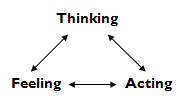In a couple of recent posts, we looked at some things you can do to help stop stress and anxiety from becoming overwhelming, and to give yourself a breathing time out from stress, anxiety and depression. In this post, we look at the Three Minute Breathing Space, another great way to manage stress and anxiety, and to help your emotions from becoming overwhelming.
The Three Minute Breathing Space was developed as part of the Mindfulness-Based Cognitive Therapy program for people with depression. Like the Breathing Time Out, it’s a way to bring your attention to the present, give yourself a break from whatever stress or emotions have been building up, and then return to the rest of your day, more refreshed and focused on the present.
Three-Minute Breathing Space This exercise is a way to step out of “automatic pilot” and bring yourself into the awareness of the present moment.
Awareness
Bringing yourself into the present moment, adopting an alert yet comfortable posture, close your eyes, if this is comfortable and bring your attention inward. Becoming aware of your body and the surface upon which you are sitting, draw your focus to the spine each vertebra stacked upon the other from sacrum to skull.Now, turning your attention to your thoughts and feelings, ask, “What thoughts and feelings are around right now? What bodily sensations are present? Acknowledge your experience in this moment, even if it is unwanted.
Gathering
Now, gently direct your awareness to your breathing, following each inbreath and each outbreath, one after the other, if necessary, saying to yourself, “I am breathing in. I am breathing out.”The breath can function as an anchor to bring you into the present moment since the breath is always with us and available at any time as a focus of attention. Regulating the inbreath with the outbreath can assist in maintaining awareness and stillness.
Expanding
Now, expanding your awareness to the whole body, imagine that you are breathing with the body as a whole including your posture and facial expression. When you’re ready, open your eyes and return to your day.
You can try this practice along with audio instructions to guide you through it from the video below:






One thought on “Three Minute Breathing Space”